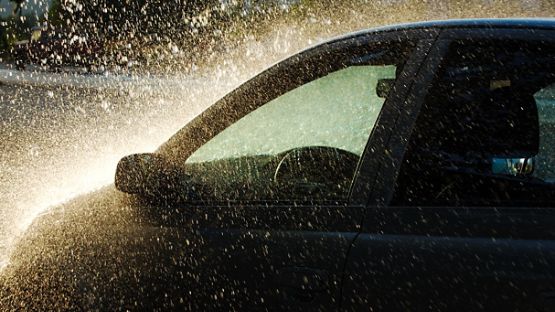Across Canada, severe weather like wind and hailstorms is most common from late spring through early fall, with peak activity typically between June and September.1 These storms can develop quickly, bringing heavy rain, powerful gusts, flying debris, and hailstones that can damage homes, vehicles, and personal property. While hail is common in many parts of Canada, certain areas experience it more frequently. If you live in hail-prone areas like Alberta’s “Hailstorm Alley,” the Prairies, or regions with frequent thunderstorms like southern Ontario and Quebec, you’ve likely witnessed how quickly the sky can change. In Atlantic Canada, high winds and storm surges can also lead to hurricanes. The good news is that there are steps you can take to prepare before the clouds roll in.
Did you know?
2024’s Calgary hailstorm is the second-costliest insured event in Canada’s history.2
How wind and hail can damage your home and vehicle
Windstorms bring strong gusts that can uproot trees, damage roofs, and scatter debris. Hailstorms occur when balls of ice form in thunderclouds and fall to the ground, often causing significant damage to roofs, siding, windows, and vehicles. Both can occur as part of severe thunderstorms or even during hurricanes. Hailstones can range in size from half a centimetre to over 10 centimetres, or from the size of a pea to the size of a grapefruit and can hit the ground at up to 130 kilometres per hour. Combined with strong winds, hail can cause significant damage to both your home and vehicle.
Home damage
- Roofs: Hail can puncture or lift shingles, leading to potential water leaks.
- Windows and doors: Flying debris may crack glass and break window seals.
- Siding and eaves: Hail and windblown branches can dent, tear, or puncture exterior surfaces.
- Outbuildings: Wind and hail can also damage sheds, garages, and other structures on your property.
Vehicle damage
- Dents: Hail can cause widespread structural damage to your vehicle.
- Shattered glass: Flying debris from wind or hail may break windshields and windows.
- Mirror and lights: Side mirrors, headlights, and taillights are vulnerable to breakage during severe storms.
- Paint damage: Repeated hail impacts or blowing debris can chip or scratch your vehicle’s finish.
How to prepare and stay safe during severe wind and hailstorms
Storms can move quickly but knowing what to do at each stage can help you stay safe and minimize damage. Whether you’re preparing in advance, riding out the storm, or dealing with the aftermath, a clear plan can make all the difference.
Before the storm
Preparation is key to minimizing damage and ensuring safety:
- Park your vehicle in a covered area or cover it with blankets or other padding.
- Bring indoors or tie down outdoor items like patio furniture and garbage bins to prevent them from being blown around.
- Trim trees, remove dead branches, and cut down dead trees near your home to reduce the risk of them falling during high winds.
- Consider securing your windows, skylights, and doors with impact-resistant storm shutters.
- Consider talking to a roof and siding professional about installing impact-resistant roofing and/or siding (such as class 4 impact-resistant shingles and fibre cement siding) if you live in areas with moderate to high risk of hailstorms.
- Prepare a 72-hour emergency kit with essentials such as water, non-perishable food, and a flashlight.
- Review your home insurance policy with your insurance representative to ensure you have appropriate coverage and understand how to report losses in the event of a hailstorm.
Read more on the impacts of hail from the Institute for Catastrophic Loss Reduction (ICLR)

During the storm

When the winds and hail begin, it’s important to take shelter, stay informed, and keep yourself and loved ones safe.
- Seek shelter indoors, staying away from windows, skylights, and doors.
- If driving, stay in your vehicle, pull over safely, and face away from all windows to protect yourself from shattered glass.
- Stay away from trees, towers, metal fences, and poles in case of lighting.
- Monitor local weather forecasts from trusted local radio and news channels, or follow local authority social media accounts for the status of the storm and possible road closures.
Find more information on actions you can take during a hailstorm
After the storm
It can be overwhelming after a wind or hailstorm passes through your area. Take care of yourself and begin the recovery one step at a time.
- Continue to pay attention to your local news or follow local authority social media accounts for the latest information.
- Be aware of your surroundings and stay alert for potential secondary hazards such as flooding or power outages.
- When it’s safe, check your property, including your vehicle, for damage and clear any debris safely.
- Take photos to document any damages and keep an inventory of belongings you may need to replace. Detailed information about the damage may help expedite an insurance claim.
- If you suffer a loss, contact your insurance representative as soon as it’s safe to submit a claim. Or, if available, you can file a claim online.
Read more about hail in Canada

Looking for more tips to prepare for extreme weather?
Whatever the season, be prepared and take precautions early to help ensure the safety of your family and property.
Related articles

How to protect your roof from hail damage
Learn how to protect your roof from hail damage with proactive measures for your car and home.

How to prevent wind damage to your home
Protect your home from high winds with tips on reinforcement and preparation.

How to protect your car from hail damage
Learn how to protect your car from hail damage with practical strategies for car owners.
Sources:
The content in this article is for information purposes only and is not intended to be relied upon as specific professional or expert advice. Aviva Canada accepts no responsibility for action taken as a result of reliance on any information contained on this webpage. Aviva and the Aviva logo are trademarks used under license from the licensor.

